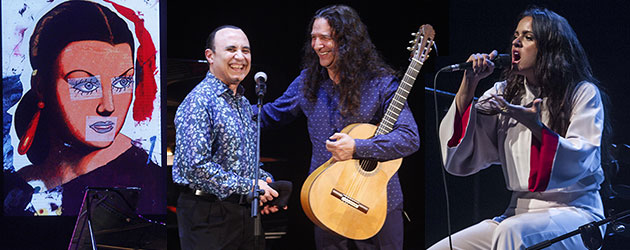José Manuel Gómez Gufi.
Photos: Pablo Sánchez Valle
Rosalía cante, Raúl Refree guitar
Auditorio El Batel, Cartagena
Tomatito, guitar. Michael Camilo, piano
Auditorio Parque Torres. Cartagena
Someone should have told Michael Camilo and Tomatito that the combination of piano and guitar is crazy, something that almost never works. Something that isn’t done because the defects outnumber the virtues, more conflict than joy. But there they are, Tomatito and Michael with their third recording, at their best moment, admiring one another, with a record of ballads. Something exceptional in especially gifted people who live in the eye of a hurricane. We’ve known Dominican Michael since the nineteen-eighties when in New York he was named world champion of jazz pianists, in the middle-weight version, a record of speed and dynamics and yet, a good jazz musician. Tomatito needs no presentation at this web.
And it sounded just great
-Wouldn’t you like to make a flamenco record one-on-one with a singer?
Tomatito- “It’s that after having been with the number one…”
-The other day Jorge Pardo told us that Camarón slept on the sofa in his house three days to learn a taranta.
Tomatito –Of course, in the apartment he had with his brother, keyboard-player Jesús Pardo, I was around there…
The seventies, Tomatito had just arrived to Camarón’s orbit and was even more timid and discreet than the singer. Hardly anyone quotes Tomatito when talking about the experiences with Camarón. We’re in the dressing-rooms of the Parque Torres auditorium with Tita, the grand-daughter of Violeta Parra, and the group of Chilean musicians participating in a tribute to the great Violeta Parra (Gracias a la Vida). Among the Chileans, the surprised face of Manuel García stands out, a star in his country fulfilling the dream of seeing Tomatito in three dimensions, the next dream is to give his adolescent son and guitarist the cassette tape his father gave him with the record of Paco de Lucía on which he interprets Latin American classics like “Tico Tico”. Manuel García comes from the area of folk, but keeps the mythology of rock and flamenco (especially of Camarón and Morente).
The concert of Tomatito and Michael Camilo was taken from those three records taking special note of Chick Corea, passing through a stimulating “Nuages” of Django Reinhart and works of Egberto Gismonti, Piazzola and Satie. “I’m not afraid of silence any more” declared the guitarist.
It’s neither flamenco nor jazz, nor the contrary, two musicians playing together or in dialogue, complementing each other, but always listening to one another.
Revolution and controversy
We don’t really know if Tomatito will ever again accompany another singer like he did Camarón, or “Enrique Morente, a guy who was always coming up with ideas”, and we don’t know if he’ll ever accompany a singer like Rosalía who came on stage after the tribute to Violeta Parra, along with Refree to face a thousand new fans who turned the stage of El Batel into the New Church of Flamenco…just an assumption.
Right off the bat, they weren’t interested in proper dress. She wore an intense white pantsuit with large bell-bottoms, and he sported a T-shirt. One-on-one, with no more accompaniment than a complicit silence. It made you want to shout out “vive la France!”
They laid out the record theme by theme, a record that Rosalía delivers very close to the original, and which Refree accompanies as best he can. The flamenco spectator loses track of any reference to the original forms since the guitarist invents the accompaniment.
Raúl Refree is a great musician, an excellent artista, a producer for the future and present, but in no way is he a typical flamenco guitarist. So he disregards all the accepted norms and codes in that regard, and he does this for a singer who appears not to want to provoke or transgress flamenco. In other words, no one plays like Refree, and that’s the game, audacious as well as minimalist, and that’s probably what drives the independent or hipster crowd crazy, so they go to see this girl no matter what she sings. It’s true that it’s impressive to listen to the songs on the record at a single go, songs about death with that voice that recalls Pepe Marchena, Valderrama and Angelillo. In live performance she shades the message inserting things from Enrique Morente, “Aunque era de Noche”, or a Cuban milonga that I wouldn’t venture to say whether it was from Pepe Marchena or Pepe de la Matrona. She sang that one about the undertaker’s daughter, and ended with the siguiriyas of Caracol, “De Plata”.
The applause of an audience of newcomers to flamenco is triggering debate among the hipsters and the avant-garde crowd, and very soon among flamencos. Mark my words.
Rosalía «Los Ángeles» – Vinilo
Michel Camilo & Tomatito «Spain forever» CD
